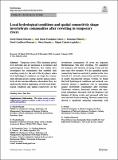Por favor, use este identificador para citar o enlazar a este item:
http://hdl.handle.net/10261/259199COMPARTIR / EXPORTAR:
 SHARE
BASE SHARE
BASE
|
|
| Visualizar otros formatos: MARC | Dublin Core | RDF | ORE | MODS | METS | DIDL | DATACITE | |

| Título: | Local hydrological conditions and spatial connectivity shape invertebrate communities after rewetting in temporary rivers |
Autor: | Pineda-Morante, David CSIC ORCID; Fernández-Calero, José María; Pölsterl, Sebastian; Cunillera-Montcusí, David; Bonada, Núria; Cañedo-Argüelles, Miguel CSIC ORCID | Palabras clave: | Flow intermittence Aquatic insects Functional traits Spatial connectivity Network analysis Dispersal |
Fecha de publicación: | 2022 | Editor: | Springer Nature | Citación: | Hydrobiologia : doi:10.1007/s10750-022-04799-8 (2022) | Resumen: | Temporary rivers (TRs) dominate global river networks and are increasing in occurrence and spatiotemporal extent. However, few studies have investigated the communities that establish after rewetting events (i.e. the end of the dry phase), when local hydrological conditions can shape the communities through species sorting, and the spatial connectivity of sites can also influence colonisation. Here, we analysed the relative importance of both local hydrological conditions and spatial connectivity on the invertebrate communities of seven not impacted Mediterranean TRs after rewetting. We quantified the frequency and duration of drying events and the time since flow resumed. We also quantified spatial connectivity based on each site’s position in the river network (i.e. network connectivity) and the presence of nearby disconnected streams. Overall, we found that both hydrological conditions and network connectivity played a significant role in structuring aquatic invertebrate communities after rewetting. Taxonomic richness, functional richness and functional redundancy decreased with the frequency and duration of drying events and increased with time since the most recent rewetting. Network connectivity showed a significant unimodal relationship with taxonomic and functional metrics. In contrast, the presence of nearby disconnected streams was negatively related to functional richness and functional dispersion. Given that flow intermittence in Mediterranean areas is expected to intensify under future global change scenarios, our results can be helpful to guide future conservation and management actions. | Descripción: | Este artículo contiene 20 páginas, 5 figuras, 3 tablas. | URI: | http://hdl.handle.net/10261/259199 | ISSN: | 0018-8158 | E-ISSN: | 1573-5117 |
| Aparece en las colecciones: | (CEAB) Artículos |
Ficheros en este ítem:
| Fichero | Descripción | Tamaño | Formato | |
|---|---|---|---|---|
| Pineda 2022.pdf | 2,59 MB | Adobe PDF |  Visualizar/Abrir |
CORE Recommender
NOTA: Los ítems de Digital.CSIC están protegidos por copyright, con todos los derechos reservados, a menos que se indique lo contrario.
